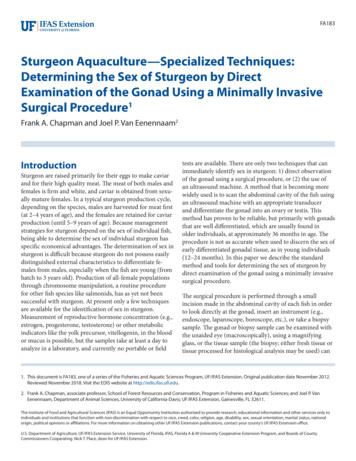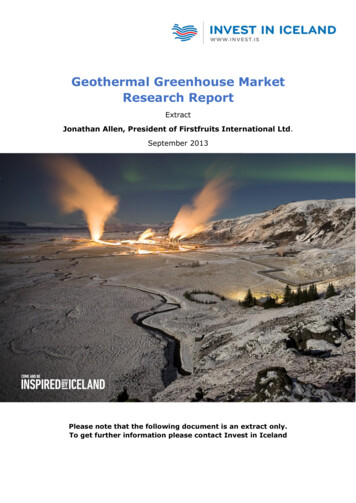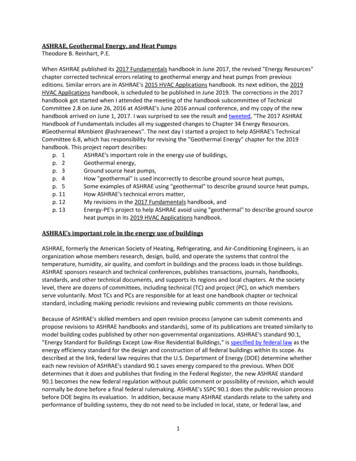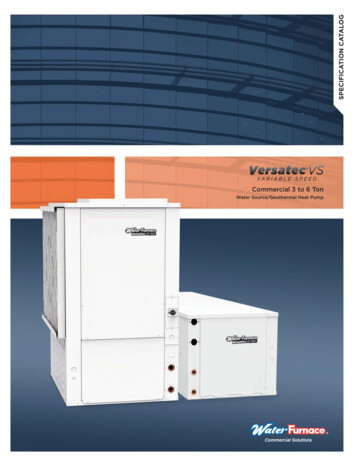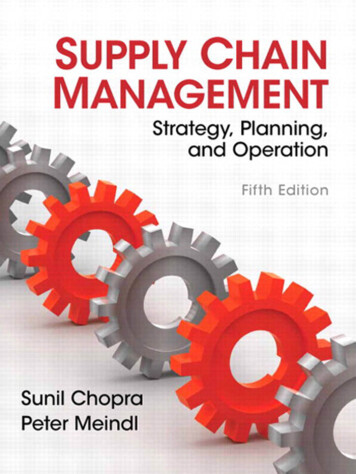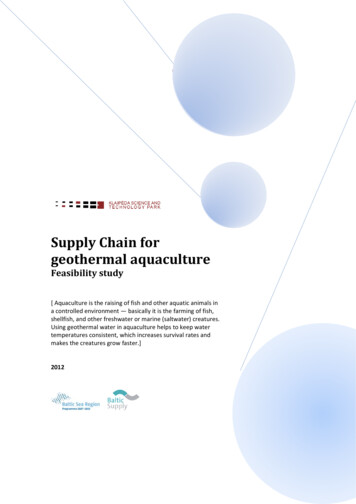
Transcription
Supply Chain forgeothermal aquacultureFeasibility study[ Aquaculture is the raising of fish and other aquatic animals ina controlled environment — basically it is the farming of fish,shellfish, and other freshwater or marine (saltwater) creatures.Using geothermal water in aquaculture helps to keep watertemperatures consistent, which increases survival rates andmakes the creatures grow faster.]2012
Content1. Direct use of geothermal resources for aquaculture applications . 2Economic impact . 2Environmental impact . 32. Background for geothermal aquaculture application in Vydmantai (Lithuania example). . 33.The characteristics of geothermal waters in Western Lithuania . 64. The list of species for possible aquaculture farms using geothermal waters in Western Lithuania. . 9Starkis - Pike-perch (Sanderlucioperca L.) . 9Artemija - Artemianauplii– for the fish food. . 11The barramundi (Latescalcarifer) . 11Pacific White Shrimp, Penaeusvannamei. 14The channel catfish Ichtaluruspunctatus . 17Tiliapija – Tiliapia Oreochromisniloticus Linnaeus, 1758 [Cichlidae] . 195. The geothermal aquaculture farm supply chain . 231
1. Direct use of geothermal resources for aquaculture applicationsAquaculture is the raising of fish and other aquatic animals in a controlled environment —basically; it is the farming of fish, shellfish, and other freshwater or marine (saltwater) creatures.Using geothermal water in aquaculture helps to keep water temperatures consistent, which increasessurvival rates and makes the creatures grow faster.Low-temperature geothermal resources that are not hot enough to produce electricity are very usefulto fish farmers. Animals grown in water of the proper temperature grow faster and larger in sizethan those in cold water or the water with fluctuating temperatures. They are also more diseaseresistant and die less frequently. Fish farmers with access to geothermal water can use it to regulatethe temperatures of their fish ponds.The scope of geothermal fish farm applications is growing rapidly. There are geothermal eel farmsin Slovakia. China has over 200 hectares of geothermal fish farms, while Japanese fish farms groweels and alligators. There are also fish farms in France, Greece, Israel, Korea, and New Zealand.The main species raised in geothermal waters are catfish, bass, trout, tilapia, sturgeon, giantfreshwater prawns, alligators, snails, coral, and tropical fish. The warmth of geothermal watermakes it possible to raise tropical marine (saltwater) species in cold, landlocked places such asLithuania.Some creatures have a range of temperatures in which they thrive. For example, catfish and shrimpgrow at about 50 percent of optimum rate at temperatures between 20 and 26 C and grow fastest atabout 90 F (32 C), but they decline at higher temperatures. Trout thrive at around 15.5 C but dislikelower or higher temperatures. All the aquaculture applications are related to thermal energy;geothermal sources make it possible to supply it at very good price and steadily.Scientists are investigating possibilities to grow plants consumable by humans and animals usinggeothermal aquaculture. Possible crops include kelp, duckweed, algae, and water hyacinth. Thetechnology still needs research to allow economically advantageous harvesting and processing.Economic impactEconomically, using geothermal energy to heat water for aquaculture can have many benefits. Thewater that has already been used for heating or electricity generation can heat fish ponds basicallyfor no cost. The savings on thermal energy according to different sources varies from 75 to 85 %.The effect on general running costs can be from 20-40 %, although as Lithuania is a cheap laborcountry the effectiveness on running costs can be even higher. There is also an economic benefit2
from selling the fish or prawns that they produce. The fish grown in geothermally heated watergrow faster. Heated water makes it possible to grow fish in winter while usually it is not bepossible. Geothermal power makes it possible to supply exotic fish species fresh for the EU market.Environmental impactA farm that uses geothermal water is not burning fossil fuels or other sources of heat to regulatewater temperature and is therefore not emitting pollutants. Many geothermal aquaculture operationsuse water that has already been used by geothermal power plants or heating systems.Aquaculture itself takes pressure off wild fisheries, many of which have been severely overfished.2. Background for geothermal aquaculture application in Vydmantai (Lithuaniaexample).Aquaculture is one of the fastest growing segments of the world agriculture market and is attractingmany into the aquaculture business who have little exposure to the technology. Researchers aredeveloping different new aquaculture technologies (closed recirculating systems, policulture ponds,new water organisms species for aquaculture etc.), or developing the existing technologies usingaquaponics systems, thermal waters or both of them. In the USA Aquaculture package is beingdevelopedspecifically for geothermal aquaculture, which includes pond-heating requirements(indoor and outdoor), information on intensive and extensive culture, information on the culture ofcommon species, current market prices for common species, and typical operating costs for ageothermal aquaculture operation. The future of geothermal direct-use applications is bright:aquaculture and greenhouse operations are continuing to expand. One of the new (in reality – notvery new) is an aquaponic system – the basic schemes of which please see below:Aquaponics: aquaculture hydroponics Basic system componentswww.townsqr.com/snsaqua/page2.htmPicture 1. Simplified Basic System Set-up3
The main advantages of such systems are:- Intensive form of aquaculture.- Aquaponic systems consume as little as 1% of the water consumed by conventional fish pondsystems;- Fish waste (N and P) is used for plant growth;- Dual-cropping;- A little amount of wastewater is released into the environment;- Hydroponic plants grow faster than those raised by conventional methods;- „Green production“ for consumersGeothermal aquaculture, the "farming" of water-dwelling creatures, uses natural warm water toincrease the growth of fish, shellfish, reptiles and amphibians. In China, for example, geothermalaquaculture is growing so fast that fish farms cover almost 2 million square meters (500 acres). InJapan, aqua farms grow eels and alligators. In the U.S. aqua farmers in Idaho, Utah, Oregon andCalifornia grow catfish, trout, alligators, and tilapia -- as well as tropical fish for pet shops. Thegeothermal aquaculture is starting in Iceland, Bulgaria, Hungary and other European countries.Future food supply worldwide appears increasingly dependent on the development of aquaculture,particularly in those countries where the use of animal proteins (meat, eggs, milk and derivates) islimited. While traditional fishing has reached near saturation, aquaculture might have importantdevelopments as its production can be planned in advance according to market conditions. Intensiveaquaculture is particularly interesting, as it can be developed using hot waters (thermalaquaculture). In fact, a direct relation exists between produced biomass and temperature, each typeof biomass having its optimal temperature. Thermal aquaculture may double fish growth withrespect to natural waters average values, being moreover independent from seasonal cycles.Where the chemical treatment of these waters is uneconomic, sufficient amounts of fresh or suitablysaline waters could be heated using the polluting geothermal fluids. These fluids will then have tobe disposed of an injection well with subsequent cost increases. The heating of cold waters withgeothermal fluids can be obtained through:1) Heat exchangers, placed outside the RAS,4
2) Radiators, submerged in the RAS,3) Submerged pipes.In case available temperatures are too low, some increase in temperature could be obtained bypassive solar systems (greenhouses, tunnels, etc.). If, on the contrary, the temperature of geothermalwaters is too high, they will have to be cooled by mixing or heat exchange with sufficient quantitiesof cold water. In any case the initial temperature of the fluids will have to be by 3-10 C higher thanthat of the aquaculture farm system, to account for losses due to heat exchange and transportation.Cultured fish species are being improved for a multitude of features including growth rate, feedconversion efficiency, body shape, dress out percentage and carcass quality. Among the commercialcharacteristics of carps, flesh quality is becoming more important to the aquaculture industry. Theconsumer dictates the flesh quality and it is a very complex characteristic.The growth rate of fish is one of the most important traits for fish farming. A high growth rateincreases production turnover and a fast growing fish reaches a higher body weight before the onsetof sexual maturation. A medium to high positive correlation between growth rate and feedconversion rate has been recorded. Thus, selection for a high growth rate often results in improvedfeed conversion. Accurate prediction of the growth potential of a fish stock under given husbandryand culture conditions is an essential prerequisite for any aquaculture production research.It is very important to consider the tolerance of temperature fluctuations and height temperatures ofselected fish species. The best temperatures for the growing technologies is 24 - 28 Co .At present, there is a long list of fish species cultivated in aquaculture farms. Usually, in temperateor cold climate zone aquaculture is based on pond or RAS systems growing carp, trout, salmon,pikeperch and some other species. Geothermal fluidsis creating a new advantages for theaquaculture in temperate and cold climate zone increasing availability to cultivate new fast growingfish species and other water organisms (as shrimps, for example). The proposed list of speciesselected according to multiple criteria mentioned above is not finite and could be expandedaccording to the technology selected.5
3.The characteristics of geothermal waters in Western LithuaniaWestern Lithuania geothermal field allows using in the region 75-90 C from the Cambrianaquifers and 100-145 C of the crystalline basement (lying 2.5 - 4.5 km depth) thermal powergeneration using the latest version of Kalina cycle technology. Geothermal energy resources inWestern Lithuania are quite large. Hydrogeothermical Cambrian complex resources alone are morethan 5.1x109 GJ. It is estimated that on average of one pair of wells can produce 5 MW of power toserve 10-20 years. Near the Klaipeda Free Economic Zone and in Rimkai there are 4 boreholesdrilled into the Devonian layer (depth 1100 m). Water temperature is 38 C in them, the salinity 95 g / l (chloride - sulfate). In Vydmantai we have 2 wells in the Cambrian layer (depth 2000 m),water temperature 73 C and salinity - 170 g / l (chloride).Picture 2. Location of wells in Klaipeda6
Picture 3. Location of wells hols in Vidmantai7
Table 1. The main characteristics of geothermal waters in Western 987-1997Temperature: 4170170167167.5Sodium: Na 3259728200364423467036000Potassium: K 814910872704722Calcium: Ca2 2327629300218902382021820Magnesium: Mg2 36733850380423173819Strontium: Sr2 430452Manganese: Mn2 2105115507,268.5Iron: Fe2 40Ammonium: NH4 8Chlorine: Cl-102295105700106380104000103000Sulfate: SO42-3133121912550Bicarbonate: HCO3-348954832Bromine: Br-826780803770790824
4. The list of species for possible aquaculture farms using geothermal waters inWestern Lithuania.Starkis - Pike-perch (Sanderlucioperca L.)The beginning of pike-perch culture date to the nineteenth century and pike perch was produced ininsignificant quantities as a so-called additional fish in carp ponds. It was produced in monoculture(summer fry) or in polyculture with carp (fall fry). Pond pike-perch culture also began to develop inWestern Europe (e.g. France) in the second half of the twentieth century. This type of pike-perchproduction has been and remains extensive in character, and this species has been and currently isviewed only as a supplementary fish.At the beginning of the twenty-first century, the firstaquaculture facilities producing pike-perch in recirculation aquaculture systems (RAS) wereestablished in Western Europe and, by the close of the first decade, there were less than ten of thesefacilities. Methods for intensive pike-perch culture are in the initial stages of development but thisspecies is considered to offer good prospects for European aquaculture. Currently, the mainproducing countries are the Czech Republic, Denmark, Hungary, Romania, Tunisia and Ukraine. Inaddition to the other countries shown on the FAO map, pike-perch are also grown in theNetherlands and Poland.Picture 4. Main producer countries of Pike-perch (FAO FisheryStatistic, 2009)9
For the geothermal waters proposed production system is RAS.According FAO information this isthe newest method, and it is used at hatcheries equipped with RAS and cooling systems forreducing water temperatures. Fish are stimulated environmentally (temperature and photoperiod).Thermal stimulation lasts for 18 weeks – 8 weeks cooling phase (20-8 C), 6 weeks chilling phase(8-4-8 C), 4 weeks warming phase (8-12 C). Photoperiod stimulation is used exclusively duringthe warming phase when it is changed from 8L:16D to 14L:10D.This method is still underdevelopment; fewer than ten facilities in Europe are currently using it. Juveniles of 15-30 g arestocked. In the initial stages (BW 15-100 g), when 2-5 m³ tanks are used, the stock is maintained at10-30 kg/m³. Larger tanks (20-30 m³) are used for the final stage, in which the fish are reared to 1kg at a maximum stocking density of 80 kg/m³. The fish are sorted 2 or 3 times, firstly at 100-150 g,secondly at 200-250 g, and thirdly when the fish attain 500-600 g. Fish of 1 kg can be obtainedafter about 15-18 months of on-growing in RAS.The thermal optimum for pike-perch growth isabout 27-28 C but fast growth rates are already noted at 23 C. The following contribute to thecosts of producing 9-10 g fingerlings in RAS (initially stocked with 0.2-0.5 g summer fry fromearthen ponds): labor 40 percent, energy 28 percent, feed 12 percent, fry 20 percent.The cost of producing 10 g fingerlings in RAS (2009) is USD 0.6/individual. Labor costs are 43percent of the overall costs, depreciation 12 percent, and feed 7-10 percent. The way to lower costsis to increase the scale of production and to improve culture efficiency, especially survival. The costof producing marketable pike-perch (final BW 1.5 kg) is estimated to be USD 6.2-7.0/kg.Picture 5. Global aquaculture production ofSander lucioperca (FAO FisheryStatistic)10
Artemija - Artemianauplii– for the fish food.New technology is under development at present and it could be possible to grow this species ingeothermal aquaculture farm for fish food as additional aquaculture product.The barramundi (Latescalcarifer)Aquaculture of this species started in the 1970s in Thailand, and rapidly spread throughout much ofSoutheast Asia. Most of the research done in northern Australia has focused on pond culture,however, much of this technology is being transferred to tank culture systems, Tank culturetechnology has made it possible for most mainland states to produce barramundi. Growing ofbarramundi in RAS started in Europe from end of last century.Picture 6. Main producer countries of Latescalcarifer (FAO FisheryStatistics,11
Picture 7. Production cycle of LatescalcariferMost barramundi culture is undertaken in net cages. Both floating and fixed cages are used; theserange in size from 3 3 m up to 10 10 m, and 2–3 m depth. In Australia and the United States ofAmerica, a number of barramundi farms have been established using recirculation freshwater orbrackish water systems with a combination of physical and biological filtration. These farms maybe located in regions where barramundi could not otherwise be farmed because of consistently lowtemperatures (southern Australia, north-eastern United States of America). The major advantage ofsuch culture systems is that they can be sited near to markets in these areas, thus reducing transportcosts for the finished product.Stocking rates in tank systems vary, depending on the capacity of the system and the intensity of theoperation. Many producers work on a stocking rate of around 30-40kg/m3, however more advancedsystems may be able to increase the stocking rate, depending on the experience of the farmer andhusbandry practices used.12
The optimum temperature for barramundi culture is 28 C, with acceptable growth rates between 2630 C. Temperatures below this range will result in decreased metabolism and growth. Barramundigenerally stop feeding at temperatures below 20 C. To maintain acceptable growing temperatureconditions, some existing farms rely on the use of warm subterranean bore water and climatecontrolled or insulated sheds. Expensive alternatives include the heating of individual tanks withelectric submerged heaters. At optimum temperatures, barramundi can be raised to market size(500g) between 6-12 months.Economic models of barramundi farming in Australia have estimated the break-even cost for asmall (50 tonnes/yr) Australian farm to be AUD 9.25/kg (USD 6.90/kg), and the break-even cost fora 200 tonnes/yr farm at AUD 6.90 (USD 5.1). Larger farms ( 1 000 tonnes/yr) are able to takeadvantage of economies of scale and their production costs are likely to be around AUD 6–7/kg(USD 4.50–5.25/kg). In contrast, barramundi farms in Thailand can produce fish for USD 1.90/kg.Economic modeling of Australian barramundi farms indicated that profitability was particularlysensitive to price, with a decrease of AUD 1.00 (USD 0.75) resulting in an 80 percent decrease inequivalent annual return.Picture 8. Global aquaculture production of Latescalcarifer (FAO Fishery Statistic)Annual barramundi production has been relatively static since 1998, at 20 000–27 000 tons.Thailand is the major producer, with about 8 000 tons/yr since 2001. Indonesia, Malaysia andTaiwan Province of China are also major producers. The global average value of farmedbarramundi was USD 3.80/kg in 1994 and rose to USD 4.59/kg in 1995 but had fallen to USD 3.92by 1997. Since then it has been around USD 3.7/kg except for 2002, when it fell markedly to belowUSD 3.0/kg. Market and trade13
Pacific White Shrimp, PenaeusvannameiCaptured wild seeds were used in Latin America for extensive pond culture of Pena
Supply Chain for geothermal aquaculture Feasibility study [ Aquaculture is the raising of fish and other aquatic animals in a controlled environment — basically it is the farming of fish, shellfish, and other freshwater or marine (saltwater) creatures.

